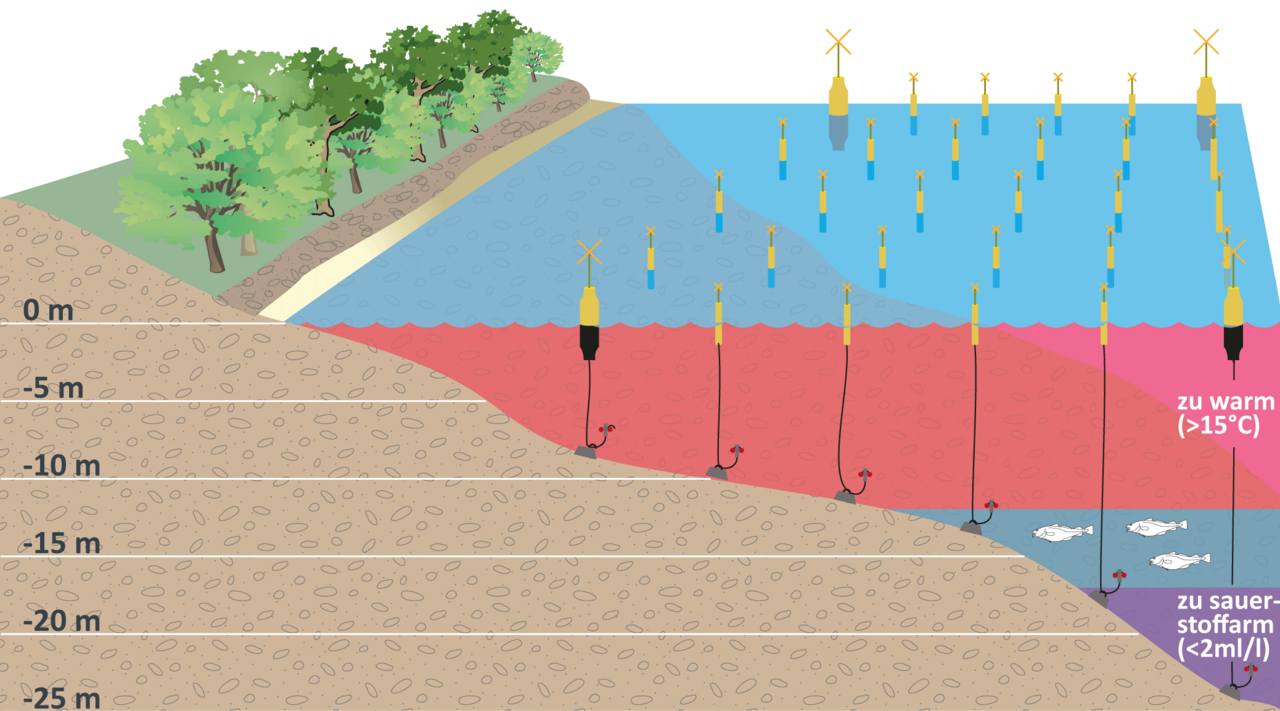Project
Cod telemetry field

Acoustic telemetry on cod and flatfish in the Bay of Lübeck
How exactly do cod and flatfish live and survive in the brackish water environment of the Baltic Sea? We equip fish with transmitters so that they can tell us about their lives - and we better understand how they behave under changing environmental conditions.
Background and Objective
The cod stock (Gadus morhua) in the western Baltic Sea is at an all-time low. Environmental changes and high fishing pressure are the most likely causes for the observed decline. Despite a recent drastic reduction in removals, the stock shows no signs of recovery. Poor recruitment over many years and thinner cod (Receveur et al., 2022) suggest that unfavorable environmental conditions play an important role in the decline. In particular, the warm summer period appears to be a bottleneck period for cod in the relatively shallow western Baltic Sea (Krumme et al. 2020), as they tend to prefer cooler temperatures.
Little is known about the individual movements and behaviors of western Baltic cod (Hüssy et al., 2020). Recent research has shown that the fish exhibit clear seasonal patterns in habitat use (Funk et al. 2020). For example, Belts Sea cod use deeper, saltier, and muddier basins only during winter spawning. After spawning, the distribution shifts to shallower areas on slopes to feed, where cod show a clear preference for areas with hard substrate. As the surface waters warm, cod are then forced to move to deeper areas on the slopes to spend the summer months. Once the shallow waters cool in October, cod regularly move from their daytime resting sites in deeper areas to their nighttime feeding sites in very shallow water (Burrows et al., 1994; Freitas et al., 2016). Slopes appear to play a key role for cod as a transitional area during their seasonal and diurnal movements.
To better understand cod life history, we investigate habitat use, movements, and behavior of adult western Baltic cod in a natural slope area in southern Mecklenburg Bay. Results from a nearby cod tagging study on an artificial reef (Nienhagen Reef) in the western Baltic Sea indicate high site fidelity of cod to reef structures. However, it is unclear whether this behavior is representative of cod behavior outside this artificial habitat (Dolk, 2015; McQueen et al., 2019).
The primary focus of this study is on cod, but because flatfish are also an important part of the community and cod densities are currently relatively low, we are investigating the life history and movement patterns of cod and flatfish together in this area. Flatfish are currently the most important demersal resource in the Baltic fisheries and more detailed knowledge of their life history is of great importance for sustainable exploitation. Details on the movement patterns of flatfishes in the western Baltic Sea are poorly known and findings from studies in other marine areas are of limited transferability due to the specifics of the Baltic Sea.
Approach
To monitor small-scale movements of individual fish, we use the method of acoustic telemetry. Acoustic telemetry consists of two components: a transmitter and a receiver. In this method, the fish carries the transmitter (Hussey et al. 2015). This transmitter emits sonic pulses into the surrounding water every few minutes that contain information about the transmitter, i.e., the tagged fish. This could be, for example, swimming depth or speed. The transmitters are either implanted in the abdominal cavity or externally attached to a fish so that a tagged fish can be "heard" by any receiver within range after release into the wild (Abecasis et al. 2019). The range is several hundred meters in the western Baltic Sea.
The selected area for the telemetry field is located on the coast near Boltenhagen, between Travemünde and Wismar. There are no major towns in the vicinity and most of the beach is still natural, although conventional agriculture is practiced right up to the edge of the cliff. The area is characterized underwater by a mix of habitats that includes stone fields, sandy areas, and seagrass and algae beds. In the summer of 2021, we installed 30 receivers in a slope area of approximately 2 x 2.5 km in an area formerly known as a good cod fishery for both anglers and commercial gillnet fishermen. The receivers are each about 500 m apart and cover water depths from about 7 m down to 24 m.
The telemetry field is marked with yellow sea buoys, vessels should keep a distance of 50 m from the sea buoys, otherwise there are no restrictions on navigation; fishing and angling is not prohibited. However, we would like to appeal to all fishers and anglers in the area to avoid fishing in this area to ensure that fish can be observed in their natural behavior.
Data and Methods
The receivers are small, data-capturing computers anchored near the seafloor that "listen" for tagged fish. When a signal is detected, the unique ID code of the transmitter is stored with the date and time. Data from a single receiver provides information about each visit of a tagged fish to that location. This data can be read when a receiver is brought to the water surface. In our cod telemetry field, 30 receivers monitor fish movements over an area of about 10 square kilometers.
Larger cod and flatfish are additionally equipped with a data storage tag (DST). The DST records time, temperature and pressure data. When these fish are recaptured or the DST is found on the beach, the data is used to reconstruct the fish's movements from the day of release to the day of recapture. All fish tagged with an acoustic transmitter and/or a DST will also be marked externally with two colored spaghetti tags. A reward of 100 euros will be paid for each fish if it is returned to us complete.
Oceanographic instruments are attached to the receivers to record temperature, salinity, oxygen and current direction in such a way that changes near the bottom are monitored around the clock throughout the area. We use the oceanographic parameters and instruments together with the Leibniz Institute for Baltic Sea Research in Warnemünde (IOW). This allows us to track in detail the fluctuations in the water body of the telemetry field and changes in the movement patterns of the tagged fish.
Our Research Questions
The objective of this study is to use acoustic telemetry and data loggers to investigate how individual cod and flatfish in the western Baltic Sea use a slope area with a typical habitat mix of rocky areas, sandy areas, and seagrass and algal beds. Specifically, the research questions are:
1) To what extent do cod and flatfish show site fidelity in a natural slope area in the western Baltic Sea?
2) How do cod and flatfish move and behave in this slope area over time (day, sunset, night, sunrise; season) and in interaction with fluctuating environmental conditions?
Preliminary Results
Attempts to tag cod were not very successful due to low numbers of larger fish in 2021/2022. Tagging of additional fish will continue in 2023.
While the tagging campaign was slow to get underway, oceanographic data showed alarming results that may partially explain the lack of cod in the area (video: www.ndr.de/fernsehen/sendungen/45_min/Schoene-tote-Ostsee-Das-Dorschsterben-und-die-Folgen,sendung1249608.html; media articles: https://www.ndr.de/nachrichten/mecklenburg-vorpommern/Forschungsprojekt-ohne-Probanden-Dorsch-vergeblich-gesucht-,fangquote160.html; https://www.riffreporter.de/de/umwelt/phosphor-ostsee-duenger-eutrophierung-todeszone-dorsch; https://www.nationalgeographic.de/sterben-in-der-ostsee-ist-der-dorsch-zu-retten-uberfischung). In August 2021, the surface water in the area was too warm for cod, while the water below the thermocline had oxygen levels too low for cod to survive there permanently. It is unclear whether cod that previously lived in this area have moved to other areas or died. Regular measurements of salinity, temperature, and oxygen throughout the water column (CTD measurements) along a fixed transect from the very shallow area to the deeper basin of Mecklenburg Bay, revealed that the water below the thermocline was hypoxic for several months (i.e., had oxygen levels less than 2 mg/l), suggesting that large areas of Mecklenburg Bay may be unusable as habitat for cod and other fish species and marine invertebrates during the summer, negatively affecting their population dynamics. Regular cruises by the FRV "CLUPEA" and "BELONE" in 2022 showed that oxygen deficiency in deep water and warm water in shallow water could be observed from summer to fall again. Measurements outside the telemetry field showed that this is a more widespread problem.
Links and Downloads
Literature:
Abecasis, D. et al. (2018) ‘A review of acoustic telemetry in Europe and the need for a regional aquatic telemetry network’, Animal Biotelemetry, 6(1), pp. 1–7. Available at: doi.org/10.1186/s40317-018-0156-0.
Burrows, M.T. et al. (1994) ‘Temporal patterns of movement in juvenile flatfishes and their predators: underwater television observations’, Journal of Experimental Marine Biology and Ecology, 177(2), pp. 251–268. Available at: doi.org/10.1016/0022-0981(94)90240-2.
Dolk, B. (2015) ‘Riffe in der Ostsee - Untersuchungen zum Wanderverhalten der Dorsche - Endbericht’.
Freitas, C. et al. (2015) ‘Behavioral responses of Atlantic cod to sea temperature changes’, Ecology and Evolution, 5(10), pp. 2070–2083. Available at: doi.org/10.1002/ece3.1496.
Freitas, C. et al. (2016) ‘Temperature-associated habitat selection in a cold-water marine fish’, Journal of Animal Ecology, 85(3), pp. 628–637. Available at: doi.org/10.1111/1365-2656.12458.
Funk, S. et al. (2020) ‘Gillnet fishers’ knowledge reveals seasonality in depth and habitat use of cod (Gadus morhua) in the Western Baltic Sea’, ICES Journal of Marine Science, 77(5), pp. 1816–1829. Available at: doi.org/10.1093/icesjms/fsaa071.
Hussey, N.E. et al. (2015) ‘Aquatic animal telemetry: A panoramic window into the underwater world’, Science, 348(6240), p. 1255642. Available at: doi.org/10.1126/science.1255642.
Hüssy, K. et al. (2020) Tagging Baltic Cod – TABACOD. Eastern Baltic cod: Solving the ageing and stock assessment problems with combined state-of-the-art tagging methods.
Krumme, U. et al. (2020) ‘Age validation of age 0-3 wild cod Gadus morhua in the western Baltic Sea through mark-recapture and tetracycline marking of otoliths’, Marine Ecology Progress Series, 645, pp. 141–158. Available at: doi.org/10.3354/meps13380.
McQueen, K. et al. (2019) ‘Growth of cod (Gadus morhua) in the western baltic sea: Estimating improved growth parameters from tag–recapture data’, Canadian Journal of Fisheries and Aquatic Sciences, 76(8), pp. 1326–1337. Available at: doi.org/10.1139/cjfas-2018-0081.
Receveur, A. et al. (2022) ‘Western Baltic cod in distress: decline in energy reserves since 1977’, ICES Journal of Marine Science, 79(4), pp. 1187–1201. Available at: doi.org/10.1093/icesjms/fsac042.
Thünen-Contact

Involved Thünen-Partners
- Conrad, FrankOF Institute of Baltic Sea Fisheries
- Haase, StefanieOF Institute of Baltic Sea Fisheries
- Hennings, InaOF Institute of Baltic Sea Fisheries
- Jankiewicz, TomOF Institute of Baltic Sea Fisheries
- Schaber, MatthiasSF Institute of Sea Fisheries
- Stechert, RainerOF Institute of Baltic Sea Fisheries
- Strehlow, Harry VincentOF Institute of Baltic Sea Fisheries
Involved external Thünen-Partners
- Leibniz-Institut für Ostseeforschung Warnemünde (IOW)
(Warnemünde, Deutschland)
Funding Body
-
Federal Office for Agriculture and Food (BLE)
(national, öffentlich)
Duration
10.2020 - 12.2030
More Information
Project status:
ongoing

![[Translate to English:] [Translate to English:]](/media/_processed_/d/7/csm_Startseite-OF_03_c0dfd6e750.png)
![[Translate to English:] [Translate to English:]](/media/_processed_/a/3/csm_20181116-151457-Stella-Jerome-Fischfalle-Warnem%C3%BCnde-Dorsche-im-Netzk%C3%A4fig-5691_heller_3050c72fa2.png)
![[Translate to English:] Logo des Bundesministerium für Ernährung und Landwirtschaft](/media/allgemein/logos/BMEL_Logo.svg)